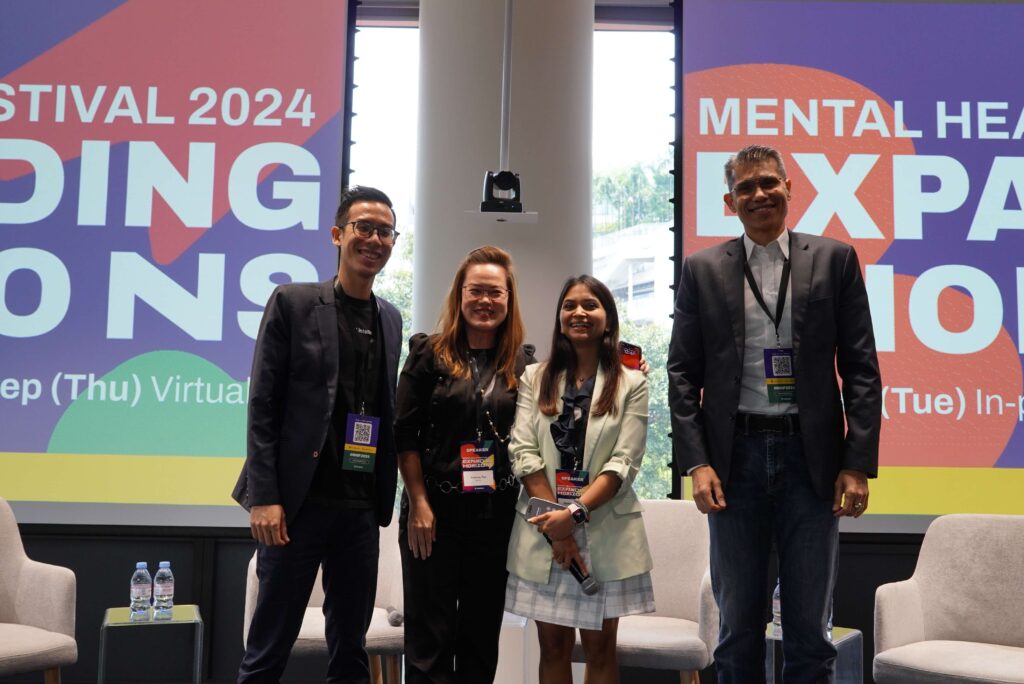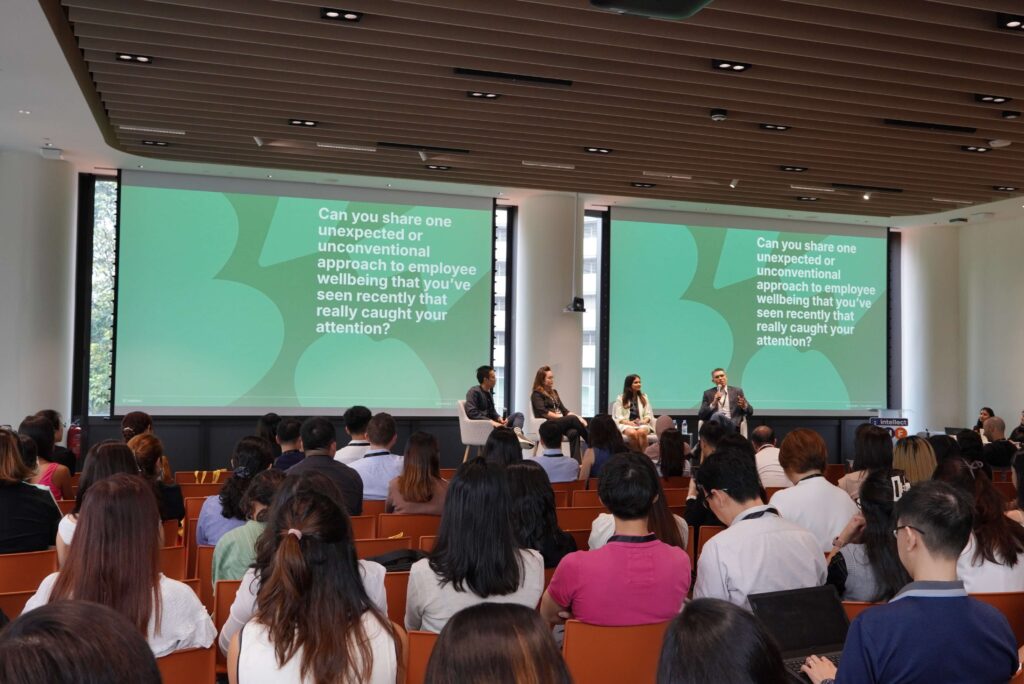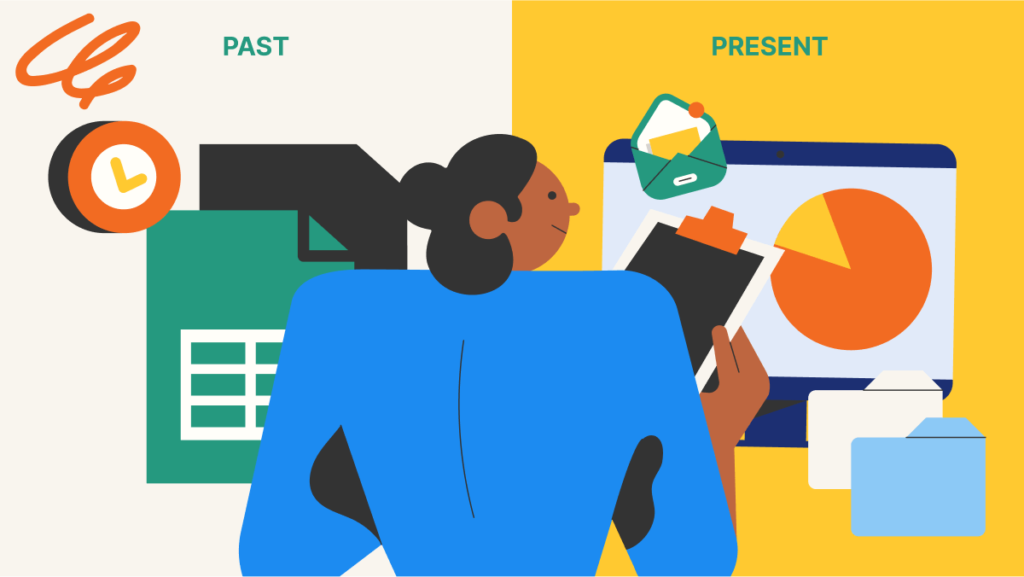HR professionals in global companies face unique challenges in fostering employee engagement and wellbeing across cultural and geographical boundaries. The larger and more widespread the organisation, the greater the responsibility.
While growth is generally seen as a positive sign for companies, it can backfire if employee wellbeing is not prioritised. As the workforce expands and diversity increases, how can we build a cohesive culture of wellbeing in a dispersed workforce?
We invited top HR leaders to talk about this in a panel interview at Intellect’s Mental Health Festival 2024: Yvonne Tan, Chief People Officer of dentsu SEA, Aslam Sardar, CEO of Institute for Human Resource Professionals (IHRP), and Meenakshree Nanda, Senior Manager, HRBP and Organisation Capability of DP World.

Employee wellbeing for everyone
1. Get buy-in across the board
Yvonne emphasised the importance of inclusive leadership at Dentsu, whose mantra is: globally consistent, locally relevant.
“It’s like bearbricks,” the CPO of dentsu SEA said, referencing the collectible designer toy known for its endless designs. “Their structure is the same, but all of them are donned in different colours and represent different cultures.”
Rather than taking a top-down approach, dentsu believes in giving everyone a voice and seeking out their perspectives in meetings, both big and small.
“When we have a meeting, it’s a very big meeting because all of their voices matter. They need to hear once from the top before taking (localisation) offline,” Yvonne added.
Having worked with over 150 nationalities and in 180 countries with DP World, Senior Manager Shree emphasises regional stakeholder buy-in. Their deep understanding of cultural nuances makes them well-suited to advance the organisation’s initiatives.
An often underappreciated source of advocacy comes from the wellbeing champions, appointed by DP World in every region to act as the organisation’s “voices, hands, and legs.”
“When promoting initiatives, it’s not just one person saying, ‘Let’s do this.’ It’s a very cohesive effort across leaders, regional stakeholders, and other individuals who aren’t necessarily from Human Resources,” she stated.

2. Redesign workload and KPI
It has become too familiar a scene whenever companies get too laser-focused on hitting KPIs, all at the expense of mismanaged workload and employee bandwidth. Aslam, CEO of IHRP, shared how this is often a slippery slope: a growth-first mindset at all costs, without the consideration of right-sizing targets.
For two years in a row, IHRP’s annual employee engagement survey revealed that workload is the top stressor. To address this issue, he began by having employees plan their workload around 200 working days. When he found that this was still inadequate, he reduced the number to 150-180 days.
In addition to man-hours, he also reviewed KPIs.
“KPI is the elephant in the room. If you don’t fix your KPI and right-size your targets, if you pursue growth at all costs, you’re going to have a problem.”
Aslam implored business leaders and HR managers to sit down and ask the tough questions.
“Is the KPI realistic? And if I push the KPI button, how is it going to affect the wellbeing of my team? I encourage you to bring such conversations back to your bosses,” he urged.

3. Over-communicate options
Stigma is a major reason why employees do not engage with wellbeing resources. Additionally, many employees don’t know their organisation even offers an EAP, making lack of awareness a close second. This is why it’s important to over-communicate.
To start, Shree recommends reaching employees through multiple platforms. Rather than relying on an easily missed newsletter or an annual town hall, she believes that regional translations and frontline help desks will make these resources much more approachable.
Furthermore, since employees de-stress in different ways, organisations should offer a variety of options. Interest groups, for example, can range from photography to cooking, ensuring that employees not only have access to these activities but also receive social support from like-minded colleagues. This creates an organic, rather than forced, approach.
“It is a pull versus a push. We’re not saying, ‘Hey, we’re holding this one event and everyone needs to come because we need attendance and participation.’ We’re offering different options, and you can pick and choose what resonates the most with you,” Shree said.
The success of such initiatives can be measured by benchmarking an organisation’s wellbeing index against companies of similar size and scale. Most importantly, the results should be communicated to employees.
“This lets people know that whatever we are doing has an impact and aligns what the business and its people want,” Shree concluded.

4. Aligning policies and people
In Singapore, nearly half employers are hesitant to hire staff with mental health conditions, according to a recent region-wide report. This highlights the disconnect between the national narrative on mental wellbeing vis-a-vis organisational buy-in, a reality Aslam attributes to a lack of progressive HR practices and processes.
“If we want to tackle this disconnect, we have to get out of our comfort zones and say, ‘How are we going to have the right practices and processes to reintegrate these individuals?,” Aslam said.
According to him, organisations have to seize this opportunity to redesign jobs, be more inclusive of individuals with mental health conditions, and help reintegrate them into the workforce. While this is underway, HR managers have the power to start making a change, from championing workplace adjustments to educating managers.
“I’m pushing this narrative out there that HR is not for HR,” he declared.
“HR is for every manager that is managing a person. If you are managing a person, you are a HR manager whether you like it or it appears in your JD.”
Contrary to popular belief, creating psychological safety is the work of all employees, no matter their rank or role. This approach may be unfamiliar, but it is necessary for organisations to keep up with the times, and for HR to keep an open mind.
“A lot of us in HR deal with things as they show up on our desk. Just like HR leading through COVID-19, we learn on the job,” Yvonne said.
Missed this session at Mental Health Festival 2024? Watch the replay here.








